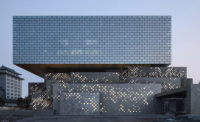Newsmaker: Ole Scheeren








|
After 15 years at the Office for Metropolitan Architecture—eight years as a partner—Ole Scheeren has split from Rem Koolhaas and set up his own firm. The new practice, called Büro Ole Scheeren, is based in Beijing (where Scheeren has lived for the past six years) and Hong Kong (where he has been a visiting professor at Hong Kong University since January 2010). He brings with him as a partner Eric Chang, an American architect who had worked at OMA in Beijing.
At OMA, the German-born Scheeren spearheaded the design and construction of the China Central Television Station (CCTV) and Television Cultural Centre (TVCC), adjacent buildings in Beijing that have become landmarks even though neither has opened yet. He also served as the partner in charge of MahaNakhon, a 1,017-foot-tall mixed-use tower planned for Bangkok, and The Interlace, a 1,040-unit residential complex planned for Singapore. Earlier in his career at OMA, he worked on the Prada Epicentres in New York City (opened in 2001) and Los Angeles (2004).
RECORD recently spoke with Scheeren about life in Beijing, leaving OMA, and plans for the future.
Clifford Pearson: You were a partner at OMA and ran the firm's Beijing office. Why leave?
Ole Scheeren: I reached a point in my life, both professionally and personally, when I needed to grow up and stand on my own. I had a fairly independent role at OMA— running the China office and my own projects—but I was still part of an existing envelope. We had completed all our work on CCTV and TVCC, so it seemed like the right time to make a break.
CP: What did you take from your time at OMA?
OS: I learned a huge amount working with Rem. My 15 years with him are a big part of my past and my reality. When I started at OMA 15 years ago, there were about 30 people. Now there are a couple of hundred. It has become a supertanker. One of the reasons I left was to get back to a smaller-size practice, to be more agile.
CP: How big is Büro Ole Scheeren?
OS: We have 20 people. About 40 percent are local Chinese, another 20 percent are Chinese-speaking, and the rest come from all over the world. This international mix is important for us; everyone brings a different perspective, a different stake in the process.
CP: What are you working on?
OS: We've been reasonably successful securing projects in our first seven months. We're working on a 250-meter (820-foot) tall tower in Kuala Lumpur, near the Petronas Towers. It will have a mix of uses, including offices, residences, and retail. We're also designing a mega development in Chongqing, an 800,000-square-meter (8.6-million-square-foot) hyper-city-block. It will have cultural and public elements, along with residential, office, and retail components. And we entered a competition for a 2,000-seat theater near Beijing and should hear very soon whether we won.
We're also doing a studio for a Beijing-based artist, a small project that brings a very contemporary design to a historical context on the outskirts of the city. That's what I want to do—work on different scales, get small, do personal projects.
CP: When OMA got the commission to design CCTV, you moved to Beijing. How has that affected your approach to design?
OS: I felt strongly that to understand the context I needed to be directly engaged with it. I've been living in China for six years now and have been going back and forth here for nine years. My first visit was 19 years ago. Without this intense presence here, I don't think CCTV would have happened. I'm not here just for the business; I live and work here.
CP: What's the situation in Beijing now that the Olympics are over?
OS: The city is less focused on one goal, and as a result, I think it's more mature, more grounded in real life. During the run-up to the Olympics, there was an almost hysterical focus on getting things done. This ordered the city in a particular way. But the reasons for Beijing's boom weren't just the Olympics. Even now a strong sense of growth continues. The post-Olympics bust that a lot of people predicted hasn't happened.
CP: But a lot has been lost in Beijing and the rest of China in the wake of all this construction.
OS: A loss of history is always irreplaceable. But there are emerging models of contemporary urbanism here that are quite promising and vibrant. Look at Jian Wai SOHO [a mixed-use development in Beijing designed by Riken Yamamoto, published in RECORD, March 2004, page 90] and Sanlitun [another mixed-use complex in Beijing that includes The Opposite House hotel by Kengo Kuma, published in RECORD, May 2010, page 90]. There's a quest for new models here that's quite exciting. Clients are willing to re-imagine how things can be done.
CP: How do you think the Chinese authorities have handled all the changes?
OS: China could be calmer and less reactive when it comes under criticism. For example, with the recent Nobel Peace Prize [awarded to imprisoned human-rights activist Liu Xiaobo], I don't think it needed to react the way it did. There is still a difficult and complex path ahead for China.
CP: When will CCTV open?
OS: The interior fit-out is happening right now, and the first workers will probably move in around springtime. A lot of an incredibly complex technology has to be installed too, because the client will broadcast 250 channels from the building. So the commissioning will take awhile, but should be done by the end of the summer. I don't know when the official opening will take place, though. That may wait until TVCC [which was badly damaged in a fire in February 2009] is done. Repair work on TVCC has finally begun in full.
CP: What comes next?
OS: I hope in the next year, maybe even sooner, to open an office in Europe, probably London. I like the idea of reversing the direction of influence, to bring what I've learned in the East back to the West.









